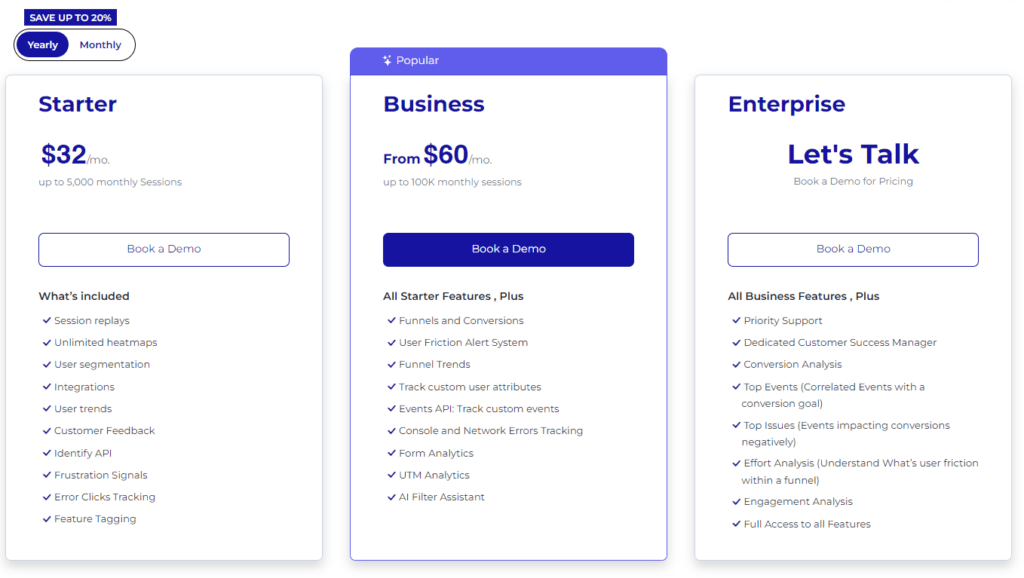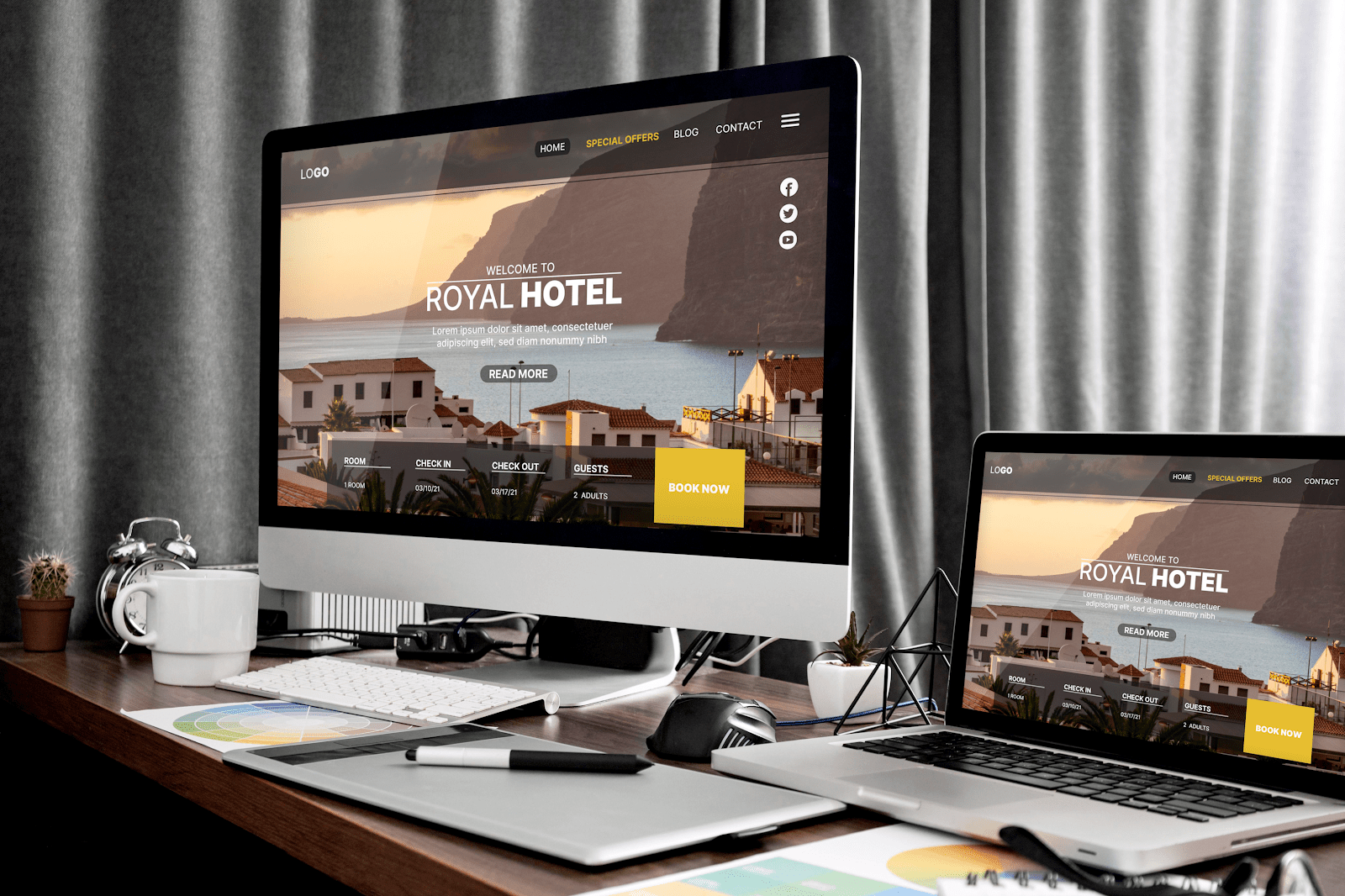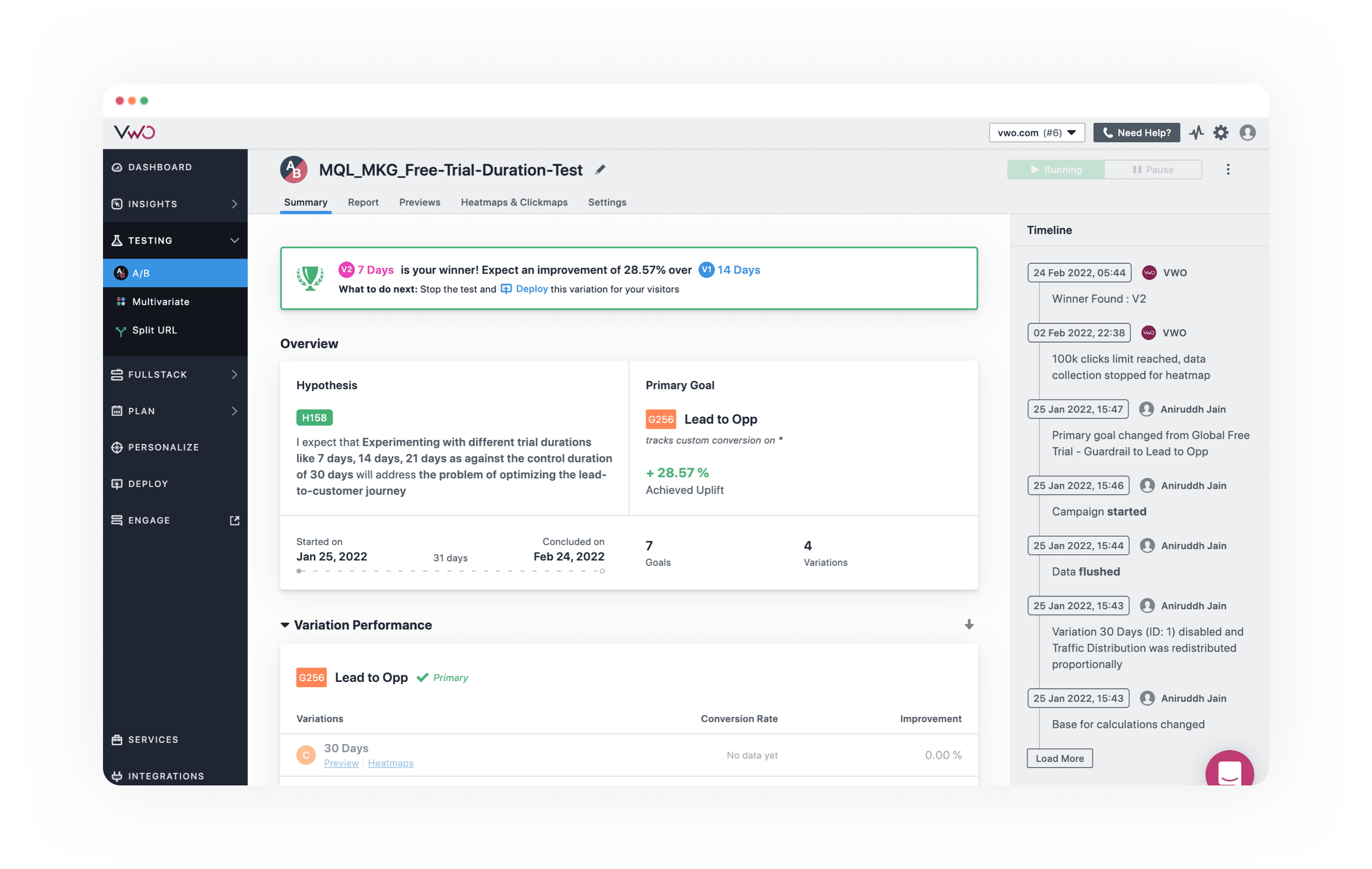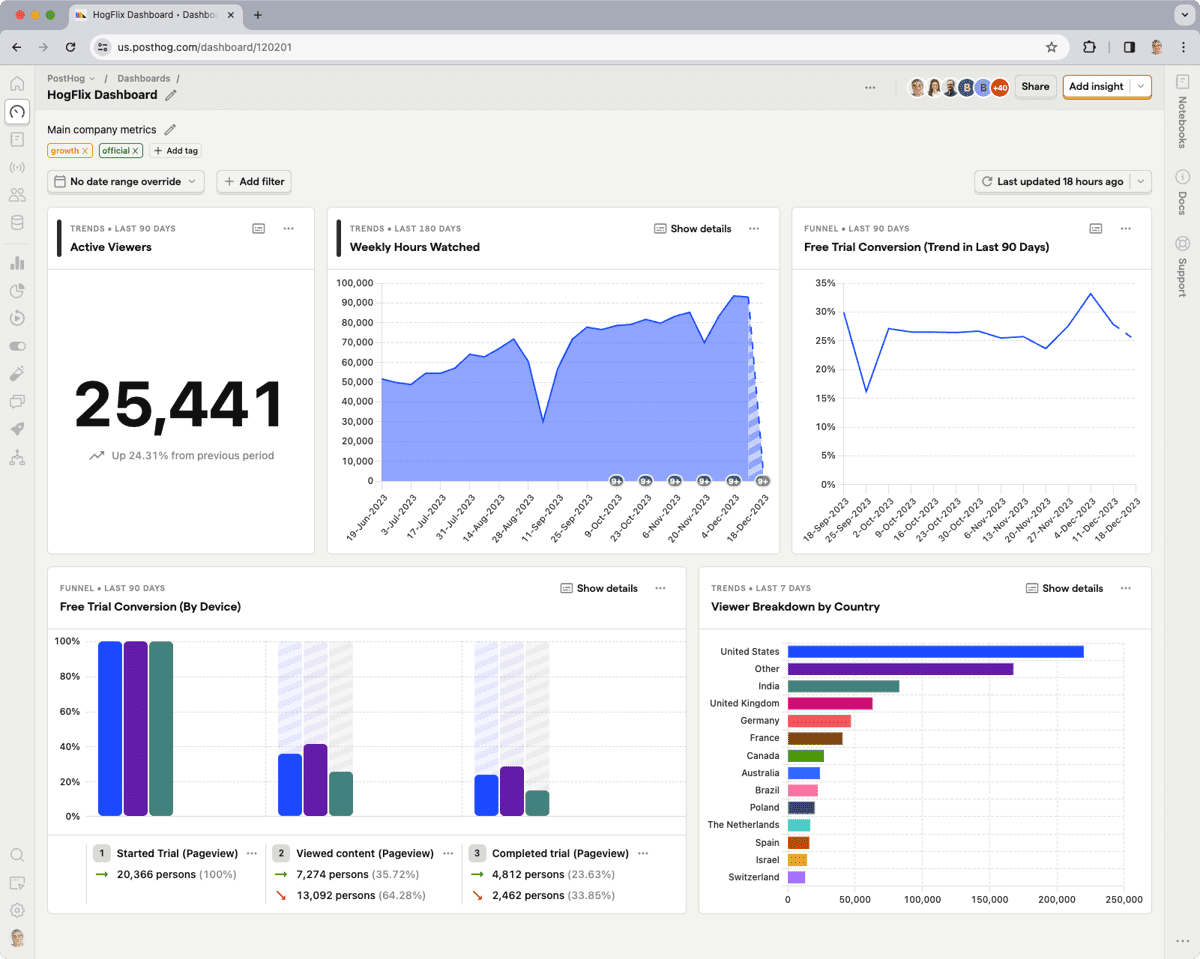Are you looking to optimize your website's performance but unsure if VWO is the right choice? You're in luck! We've compiled...
Landing pages are like digital welcome mats for your website; they're the first thing visitors see when they click on a link from an email, an ad, or another digital source.
Just as a welcoming entryway sets the tone for a visitor’s experience in a home, a well-designed landing page sets the tone for a visitor on your website. Is your web page interesting enough for visitors to explore further? Are your CTAs clear and eye-catching? Does your user interface show up well on websites?
Landing page optimization tools can answer all these questions and more.
In this guide, we'll dig deeper into what these tools do, why you need them, and some of the best landing page optimization software you should invest in.
Visualize, Analyze, and Optimize with FullSession
See how to transform user data into actionable insights for peak website performance.
What is Landing Page Optimization?
Landing Page Optimization (LPO) is all about making your landing page as effective as possible.
Essentially, it involves tweaking and testing various elements of your landing page to maximize the likelihood that visitors will take the action you want, whether that's signing up for a newsletter, buying a product, or filling out a contact form.
The goal is to improve user experience and increase conversion rates by refining content, design, and overall functionality to meet the needs of your audience better. There are several features great landing pages have in common:
- Catchy headlines: You need a headline that hooks visitors right away, telling them what you've got and why they should be interested.
- Clear and snappy content: Keep your words straightforward and to the point. Highlight the perks of what you’re offering, and maybe use bullet points to keep things neat and easy to read.
- Eye-catching call-to-action (CTA): Your CTA buttons should be hard to miss and encourage people to take action, like "Sign Up Now" or "Get Yours Today."
- Cool visuals: Use high-quality images or videos that show off your product or service and match what you’re talking about.
- Simple forms: Don’t make people fill out a novel. Ask only for the essentials to up your chances of getting those forms filled out.
- Trust builders: Throw in some testimonials, client logos, or security badges to show you’re credible and trustworthy.
- Mobile-friendly design: A ton of people browse on their phones, so make sure your page looks good and works well on mobile devices.
- Quick load times: No one likes a slow website. Make sure yours loads quickly to keep people from bouncing.
- SEO smart: Use smart SEO strategies like keywords and meta tags to help your page show up in search results.
Why Should You Optimize Your Landing Page?
Optimizing your landing page directly impacts your ability to engage visitors and convert them into customers or followers. Here’s why you should consider giving your landing page a tune-up:
Maximize Conversion Rates
The whole point of optimization is to get more visitors to take the action you want, like signing up or buying something. Small changes, like tweaking your headlines or button colors, can make a big difference.
The easier and more appealing you make the process, the more likely people are to follow through.
Reduce Advertising Costs
If your landing page makes a great first impression and gets more conversions, your ads will work harder for you. This could mean spending less money for each customer you gain.
Also, search engines like Google give better ad rates and positions to pages that perform well, so a good landing page can actually save you money.
Improve the Customer Experience
A well-thought-out landing page makes everything smoother for your visitors.
If they enjoy their time on your site because it’s easy to use and they can find what they need without hassle, they’re more likely to stick around and come back later.
Gain Valuable Insights
When you refine your landing page and test different versions, you'll see patterns in how visitors behave.
This can tell you a lot about what they like and don’t like, helping you make informed decisions not just on your website but across your business.
Stay Ahead of the Competition
Chances are, your competitors are also optimizing their landing pages. To keep up or get ahead, you need to see to it that your page is up to scratch.
An optimized landing page that grabs and holds attention can be a game-changer in a competitive market–you definitely don't want to find yourself playing a game of catch-up!
Upgrade Your Search Engine Optimization (SEO) Ranking
Search engines love sites that people find helpful and relevant. If your landing page is optimized and leads to positive user actions like longer visits or less bouncing, it's more likely to rank higher in search results.
This means more eyes on your page without extra advertising dollars.
Features to Look For in a Landing Page Optimization Tool
When you're in the market for a landing page optimization tool, there are several key features you should look for to make sure your efforts don't go to waste. Here's a rundown of what to keep an eye out for:
1. A/B Testing Capabilities
A/B testing, or split testing, lets you compare two versions of your page to each other in real-time.
You can set up one version as your control and make changes to the other—like changing the headline, switching up the images, or trying a different call-to-action (CTA). This way, you can directly see which version is more effective at converting visitors into leads or customers.
When looking for tools with A/B testing capabilities, make sure they offer detailed control over the elements you can test. The best tools let you experiment not just with visual elements but also with structural changes—think rearranging the layout or testing different content blocks.
Additionally, it's important that your landing page optimization tool provides comprehensive tracking and analytics for each version. You’ll want to see not just overall conversion rates but also how different segments of your audience respond to each version. This can help you fine-tune your approach based on specific visitor behaviors and preferences.
2. Real-Time Analytics
Getting immediate insights into how your landing page is performing is a must for making quick adjustments that can improve your results. Tools equipped with real-time analytics provide you with up-to-the-minute data on key metrics like visitor behavior, conversion rates, and interaction patterns.
This instant feedback loop allows you to see the effects of changes as soon as you make them, so you're not waiting around to learn what works.
Metrics to Measure
When selecting a tool with real-time analytics, look for features that allow you to drill down into specific landing page metrics, such as:
- Conversion rate: The percentage of visitors who take a certain desired action on your landing page, such as signing up for your newsletter or buying something. It's the best measure of your landing page effectiveness.
- Traffic: Monitoring the volume of visitors to your landing page can give you a sense of its reach and how well your promotional efforts are working.
- Bounce rate: Your bounce rate tells you the percentage of visitors who exit your site after viewing only one page (in this case, your landing page). A high bounce rate could mean that your landing page isn’t engaging enough or relevant for them to stick around.
- Average time on page: The amount of time visitors spend on your landing page can indicate how engaging your content is. More time spent can imply that visitors are reading your content and considering your offer.
- Page views per visit: If your landing page links to other parts of your website, tracking this metric will show you if people are interested enough to explore more of your content or offers.
- Form abandonment rate: For landing pages with forms, this metric measures how many visitors start filling out the form but don't complete it. A high abandonment rate could suggest that your form is too long, confusing, or asking for too much information.
This level of detail can reveal valuable trends and immediate opportunities for optimization. For example, if you notice that visitors are dropping off quickly at a particular section, you can modify the content or design of that section right away and watch how the changes impact user behavior in real-time.
3. User-Friendly Interface
Nobody wants to battle through a steep learning curve or navigate clunky, confusing software. A user-friendly interface makes sure that you can jump right in and start making improvements without needing to constantly refer to a manual or support guides.
Tools that feature drag-and-drop landing page editors are especially valuable because they let you visually construct and adjust your page by simply moving elements around with your mouse, which feels more intuitive and less technical.
Look for tools that also offer intuitive controls—these are designed to make the process of modifying your page straightforward. This might include clear labeling, logical organization of features, and easy access to helpful resources like tooltips or tutorial videos.
The goal is to minimize the time spent figuring out how to use the tool and maximize the time spent actually improving your landing page.
4. Integration Options
When you're using a landing page optimization tool, it's necessary that it doesn't operate in isolation. You want it to work seamlessly with the other tools and platforms you're already using.
This means it should integrate smoothly with your email marketing platform, CRM system, analytics tools, and any other software that's part of your marketing and sales processes.
Good integration capabilities make sure that data flows freely between systems, which helps maintain consistency and accuracy across your entire digital strategy. For instance, if someone fills out a form on your landing page, their information should automatically populate in your CRM.
Similarly, actions taken on the landing page should be trackable in your analytics tools. Such a feature allows you to measure effectiveness and make informed decisions based on comprehensive data.
5. Mobile Optimization
In today's world, a significant chunk of web traffic comes from mobile devices, which makes mobile optimization non-negotiable for your landing pages.
It's important that your pages not only look good on mobile screens but also function seamlessly so that the user experience for smartphone and tablet users is as smooth as can be.
When choosing a landing page optimization tool, prioritize those that offer responsive design capabilities. This means the tool automatically adjusts the layout of your landing page to fit the screen size of the device it’s being viewed on.
Doing so helps make sure that whether someone visits your page from a desktop, a tablet, or a smartphone, the content, images, and call-to-action buttons appear in an attractive and functional manner.
Plus, it’s extremely helpful if the tool allows you to preview how your landing page elements look on different devices right from the editor. This feature lets you see in real-time how changes will appear on mobile devices and make adjustments on the fly, making sure the mobile version of your landing page is just as compelling as the desktop version.
Advanced tools might also allow you to make mobile-specific adjustments, which can be critical for optimizing user engagement and conversion rates on mobile platforms.
Best Landing Page Optimization Tools
There are dozens of landing page optimization tools to choose from, but only a few provide a comprehensive solution to the goals you want to accomplish. Here’s a list of some of the best tools available today:
1. FullSession
FullSession is a top-tier tool designed to ramp up user engagement and help skyrocket conversion rates on your site. It offers a full stack of highly intuitive features like:
- Session replays: Watch recordings of user sessions to see how visitors interact with your website, which can help you identify usability issues and opportunities for optimization.
- Heatmaps: Visualize where website visitors click, move, and scroll on your pages, which helps in understanding the most and least engaging areas.
- A/B testing: Experiment with different versions of your pages to see which elements perform best in terms of user engagement and conversion rates.
- Detailed analytics: Access comprehensive data on user behavior and website performance for more informed decision-making and targeted improvements.
- User-friendly interface: FullSession is designed to be intuitive and make it easy for teams of all skill levels to leverage the tool's full capabilities.
- Integration capabilities: Easily integrates with other tools and platforms like Google Analytics to refine data connectivity and workflow efficiency.
Improve Your UX and UI With FullSession
Learn how to visualize, analyze, and optimize your site with FullSession.
2. Unbounce
Unbounce is widely recognized for its user-friendly drag-and-drop builder, which simplifies the creation and optimization of custom landing pages. Even if you've never written a line of code in your life, Unbounce lets you effortlessly craft and customize professional-looking pages.
This feature is particularly handy for marketers and small business owners who want to launch new campaigns quickly and without relying on a developer.
The platform doesn't just make page building easy; it's also equipped with features like dynamic text replacement. This is a game-changer for PPC campaigns, as it allows you to tailor the text on your landing pages to match the keywords your visitors searched for.
Speaking of conversions, Unbounce puts a heavy emphasis on optimizing for more conversions with tools like A/B testing and targeted popups. The A/B testing feature lets you compare different versions of a page to see which one performs better with your target audience.
3. Optimizely
Optimizely's advanced testing capabilities are ideal for dissecting and analyzing how subtle changes can impact user actions and landing page SEO.
For example, Optimizely enables you to tweak and test various combinations of your page elements—from text and images to layouts and features—to see which combinations drive the best outcomes.
This level of detail is invaluable for enterprises that need to make data-driven decisions to improve their web performance systematically.
Beyond just testing, Optimizely is equipped with powerful analytics tools that provide deep insights into the results of your experiments.
You can track everything from click-through rates to conversions, and detailed reports help you understand not just what changes work but why they work, giving you a clearer picture of user preferences and behavior.
3. Leadpages
This tool's highlight feature is the vast selection of templates and landing page optimization examples it offers, which cater to a wide variety of industries and campaign goals. These templates are not only aesthetically pleasing but are also designed with conversion in mind, allowing you to customize landing pages that look good and perform well.
What makes Leadpages especially appealing is its ease of use. The drag-and-drop interface allows even those with no prior web design experience to create professional-looking pages in minutes.
In addition to its user-friendly design tools, Leadpages integrates seamlessly with a multitude of marketing tools. Whether you’re looking to connect with email marketing platforms like Mailchimp, CRM systems like Salesforce, or webinar tools like GoToWebinar, Leadpages makes it straightforward.
This integration capability means you can easily funnel the leads captured on your landing pages directly into your existing marketing workflows.
4. Instapage
Instapage is a top-tier landing page platform that excels in improving the post-click experience, which is a must for maximizing conversions.
Its strong suit lies in the sophisticated post-click optimization features it offers, designed to make sure every visitor who clicks on your ads experiences a highly relevant and targeted landing page.
One of Instapage's favorite features is its team collaboration tools. These tools make it exceptionally easy for marketing teams, designers, and project managers to work together in real-time. The platform provides seamless communication right on the landing page design itself.
Team members can leave comments, tag each other for specific feedback, and make approvals within the workspace.
Additionally, Instapage offers real-time visual on-page collaboration. This feature allows multiple team members to work on the landing page simultaneously, see live updates, and make decisions on the fly.
Instapage also integrates with many marketing tools and ad networks, including Google Ads and Facebook Ads, which makes it easier to align your landing page campaigns with your broader marketing strategies.
5. Wynter
Wynter is a bit different from traditional landing page optimization tools like Instapage or Unbounce. It's not primarily focused on the technical aspects of building and testing landing pages.
Instead, Wynter is designed to help businesses understand how their messaging resonates with their target audience.
Wynter specializes in testing and refining the messaging on your landing pages. You can submit your copy to Wynter, and it will gather feedback from panels of your target audience. This allows you to see how potential customers perceive your messaging, what confuses them, what persuades them, and what could be improved.
Another of Wynter’s key features is the ability to select panelists who match your customer profile. Whether you are targeting tech-savvy millennials or seasoned industry professionals, Wynter helps make sure that the feedback you receive comes from a representative sample of your actual customer base.
6. Google Optimize
Google Optimize is a practical tool for any business looking to get more out of their website through testing and personalization. It excels at A/B testing, letting you pit different versions of your landing pages against each other to see which one performs better in terms of engaging users and driving conversions.
If you're into deeper insights, Google Optimize also has multivariate testing, where you can tweak multiple page elements simultaneously to figure out the best combination for your audience.
One of its features is integration with Google Analytics. This means you can pull in data directly from Analytics to inform your testing strategies, making sure every change is grounded in solid evidence. Plus, its visual editor is user-friendly, so you don’t need any coding skills to make changes to your site.
Google Optimize is versatile, too. It comes in a free version that's quite robust for small to medium businesses, while the premium version, Optimize 360, offers advanced features that larger companies might need. This makes it a great choice whether you’re just starting with optimization or you need a more sophisticated setup.
And if you’re already using Google products, it integrates smoothly, making it easier to improve your web pages without disrupting your existing workflow.
7. Popupsmart
Popupsmart is a user-friendly tool designed specifically for creating and managing effective pop-up ads on websites. Unlike more general landing page optimization tools, Popupsmart focuses solely on maximizing the effectiveness of pop-ups to boost user engagement and conversions.
This landing page optimization software is one of the best at targeting specific audience segments with tailored messages based on user behavior, such as exit intent, time spent on the site, or how much of a page a user has scrolled. A feature like this helps ensure your messages are delivered at the most opportune moments.
Popupsmart also offers a variety of customizable templates. Whether you're aiming to promote a newsletter, offer a special discount, or capture leads, adapting these templates to meet specific campaign goals is straightforward.
Let FullSession Guide Your Landing Page Optimization Journey
Landing pages can be tricky. You want your page to be as enticing as possible, but you also don't want it to be crowded. At the same time, your web page should be well-performing across all devices.
With all these goals to consider, creating a great landing page is easier said than done. So, why not start strong by finding out what you need to address first?
FullSession is a web analytics tool that can help you discover what's working best and where you're lacking. With in-depth insights, thanks to website heatmap tools, customer feedback tools, and session recordings, you can make better decisions for landing page success.
Maximize Your Conversion Rate With FullSession
Learn how to visualize, analyze, and optimize your site with FullSession.
FullSession Pricing Plans

The FullSession platform offers a 14-day free trial. It provides two paid plans—Basic and Business. Here are more details on each plan.
- The Starter plan costs $39/month or $32/year and allows you to monitor up to 5,000 monthly sessions with up to 6 months of data storage.
- The Business plan costs $75/month or $60/year and helps you to track and analyze up to 100,000 monthly sessions with up to 12 months of data storage.
- The Enterprise plan has custom pricing and offers customizable sessions plus full access to all features.
Optimize Your Landing Page Right Now
It takes less than 5 minutes to set up your landing page optimization tools with FullSession, and it's completely free!
FAQs About Landing Page Optimization Tools
Can I optimize a landing page on my own, or do I need a professional?
Whether you can handle landing page optimization by yourself really boils down to how comfortable you are with the tools and how complex the tweaks you want to make are. For simple changes, a lot of the landing page optimization tools out there are pretty straightforward. But if you’re looking to do some heavy-duty stuff, like seriously integrating with other systems or doing a lot of detailed split testing, it might be a good idea to bring in a pro who knows their way around these things.
How do I know if my landing page optimization is working?
The most direct way to measure the effectiveness of your landing page optimization is by tracking conversion rates. If more visitors are taking the desired action (like signing up, purchasing, or downloading), then your optimizations are likely effective.
Do I need different strategies for optimizing landing pages for different types of products or services?
Absolutely, the strategy definitely changes based on what you're selling. For example, a landing page for a pricey B2B software is going to look a lot different from one that's selling everyday consumer products. The B2B page will likely be packed with details, featuring stuff like testimonials, case studies, and a form to request demos because it needs to convince business customers who are looking for specifics. On the flip side, if you're selling directly to consumers, the page will probably be more about catching the eye with great visuals and offering quick, easy purchase options without bogging down visitors with too much text.





